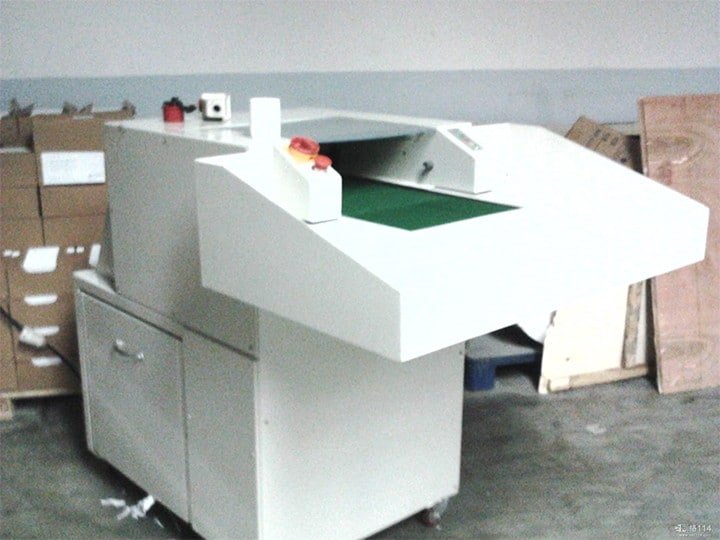파쇄방법
종이 분쇄기는 회전 블레이드, 종이 빗 및 구동 모터 세트로 구성됩니다. 종이는 바이트 사이에 공급되며 기밀 유지 목적을 달성하기 위해 여러 개의 작은 종이 조각으로 나뉩니다. 파쇄법이란 종이를 파쇄기로 가공한 후 파쇄기로 파쇄한 후의 형태를 말합니다. 종이세단기의 구성방법에 따르면 기존의 파쇄방법으로는 파쇄형, 분할형, 발포형, 줄무늬형, 입형형, 나사형형 등이 있다. 일반적인 사무실 행사인 경우 세분화된, 필라멘트형, 세그먼트 또는 스트립을 선택하십시오.
파쇄능력
종이세단기의 용량은 종이세단기가 한번에 처리할 수 있는 종이두께와 종이수량을 말합니다. 일반적으로 파쇄 효과가 좋을수록 파쇄 능력은 낮아집니다. 예를 들어, 특정 브랜드의 종이세단기의 공칭 파쇄 용량은 A4, 70g, 7~9장입니다. 즉, 해당 세단기는 A4 크기 70g을 7~9장의 두께로 파쇄할 수 있다는 의미입니다. 일반 사무실에서는 일상 업무 요구 사항에 맞게 A4, 70g, 3-4장을 선택할 수 있으며, 대규모 사무실인 경우 필요에 따라 적합한 형식과 더 빠른 문서 분쇄기를 선택하세요. 기존 대형 분쇄기는 일반적으로 매번 60-70매에 도달할 수 있습니다.
파쇄된 종이 효과
파쇄 효과는 파쇄기가 종이를 처리한 후 형성되는 폐지의 크기를 나타내며 일반적으로 밀리미터(mm) 단위입니다. 과립과 폼이 가장 좋은 효과를 내고, 부서진 모양이 그 다음이며, 스트립과 세그먼트는 효과가 상대적으로 떨어집니다. 예를 들어, 2*2mm 보안 효과는 A4 용지를 1500개 이상으로 자를 수 있습니다. 다른 경우, 실제 요구에 따라 다른 파쇄 효과를 가진 종이 파쇄기를 선택할 수 있습니다. 예를 들어, 기밀이 관련되지 않은 경우에는 가족 및 소규모 사무실에서 4mm*50mm, 4mm*30mm 등의 사양을 선택할 수 있습니다. 기밀이 필요한 경우, 컴퓨터로 인쇄된 문서는 데이터 파기 최소 표준에 따라 3.8mm 미만의 종이 조각으로 파쇄해야 합니다. 매우 기밀한 문서의 경우, 수직 및 수평으로 절단할 수 있는 종이 파쇄기를 사용해야 하며, 파쇄 효과가 3mm*3mm 이하인 종이 파쇄기를 선택하는 것이 가장 좋습니다.
파쇄 속도
파쇄속도는 종이세단기의 처리능력을 의미합니다. 일반적으로 분당 3미터 등 분당 처리할 수 있는 폐지의 총 길이로 측정하는데, 이는 파쇄되기 전 분당 처리할 수 있는 종이의 총 길이를 의미한다. 물론 센티미터로 표시하는 경우도 있는데, 실제로는 동일합니다.
파쇄된 종이의 양
바구니 위의 절단된 조각은 폐지 바구니에 간단히 놓입니다. 조금 더 비싼 제품에는 폐지 바구니(파쇄된 종이 상자)가 함께 제공됩니다. 대부분의 사무실 파쇄기는 일반적으로 사무실에서 쉽게 이동할 수 있는 바퀴가 달린 폐쇄형 캐비닛입니다. 이 유형의 종이 분쇄기에는 분쇄기 상자의 부피 선택이 포함됩니다. 일반 사무실 및 가정용 종이 분쇄기는 실제 요구 사항과 공간 크기에 따라 더 작은 용량의 분쇄기 상자를 선택할 수 있으며 크기는 10-15 리터입니다. 중형 사무실은 20~30리터에 가장 적합하고, 대규모 사무실도 사용할 수 있습니다. 30리터 이상의 잘게 썬 판지 상자를 사용하십시오. 마지막으로 비닐봉지를 걸 수 있는 선반이 달린 종이 분쇄기도 있습니다. 이렇게 해서 선반에 걸 수 있는 비닐봉지만 준비하시면 됩니다.
다른
다른 특징은 종이세단기와 일반 종이세단기의 차이점을 말하며, 신용카드나 스테이플 등을 파쇄할 수 있는 슈퍼 복합 절단기의 사용, 그리고 종이 급지/배지 기능의 정확한 전자 유도. 일부 제품에는 과중량/과열/과부하/전체 용지/폐지 상자 열기 및 전원 끄기 장치, 기계 헤드 리프팅 전원 끄기 보호 시스템, 자동 대기/정지/과부하 하역 등이 있습니다.
